Tumut Visitor Centre
Tumut area in Kosciuszko National Park
Overview
Tumut Visitor Centre, on Snowy Mountains Highway, is the ideal starting point for a visit to northern Kosciuszko National Park, offering information, booking services, and souvenirs.
- Type
- Visitor centres
- Where
- Tumut area in Kosciuszko National Park in Snowy Mountains
- Accessibility
- Easy
- Entry fees
-
No park entry fees apply at the visitor centre.
- Opening times
9am to 5pm daily. Closed on Christmas Day.
- Please note
- The visitor centre is located outside the park. Park entry fees apply within areas of Kosciuszko National Park.
- You can fill in a trip intention form and hire a Personal Locator Beacon (PLB) for free at Tumut Visitor Centre.
Northern Kosciusko National Park and Tumut Region covers a vast area: where to begin? Your best bet is Tumut Visitor Centre, located a short drive from the park in Tumut's historic Old Butter Factory.
As well as a 24-hour tourism touch screen, and a retail shop stocking visitor guides, topographical and 4WD maps, you'll find friendly, knowledgeable staff who can offer great tips and help you plan your Kosciuszko adventure. Book accommodation, or get advice on road conditions, fire warnings and other important information about Kosciuszko National Park.
While you're here, don't miss the visitor centre's corroboree frogs on display or the local exhibition space. For something a little different, ask the visitor centre about guided tours in the national park.
Map
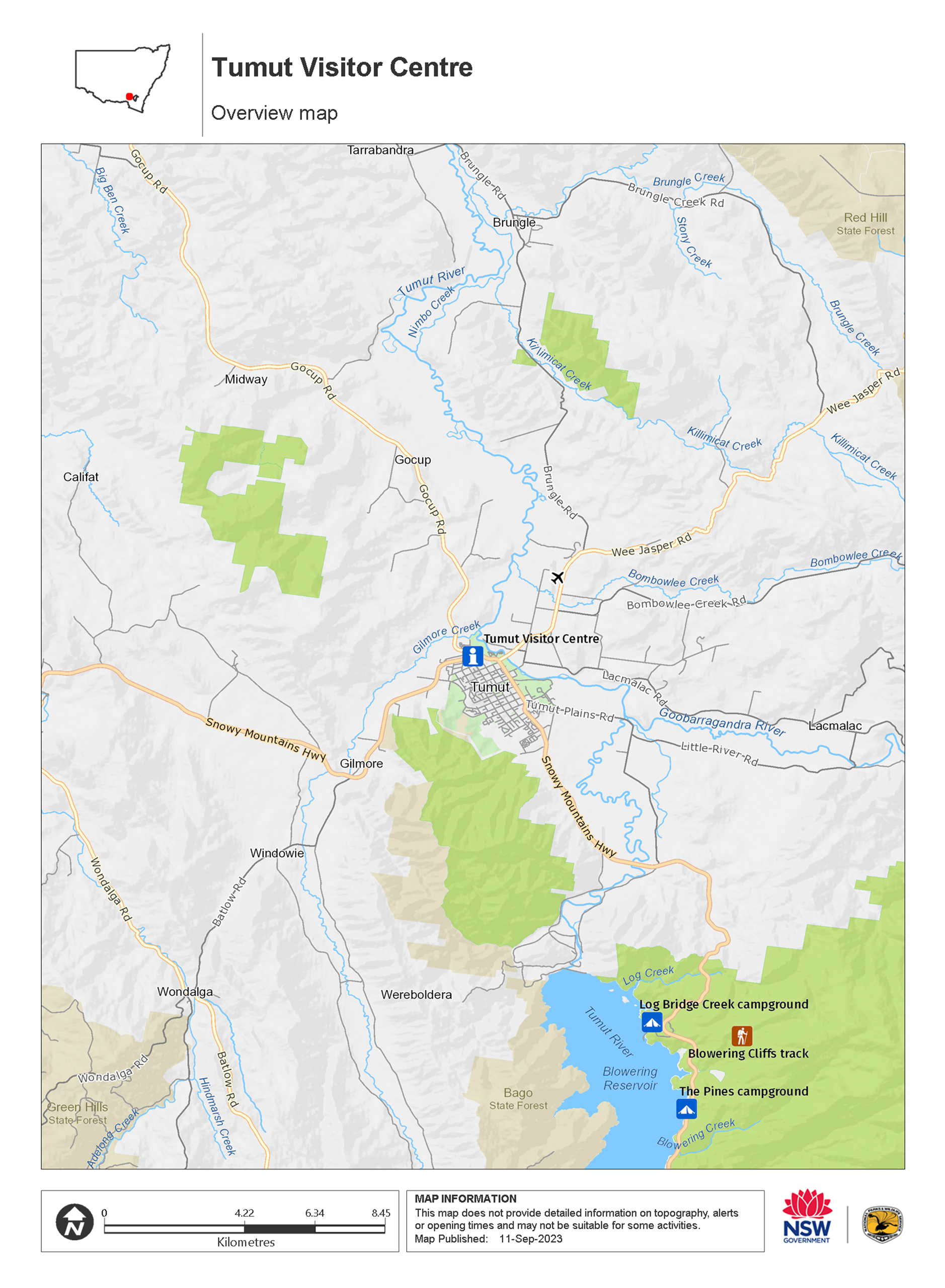
Map legend

Local alerts
For the latest updates on fires, closures and other alerts in this area, see https://www.nationalparks.nsw.gov.au/things-to-do/visitor-centres/tumut-visitor-centre/local-alerts
Park info
- in the Tumut area of Kosciuszko National Park in the Snowy Mountains region
The Tumut area is open all year but some roads and trails may close due to weather conditions or park management issues.
-
No park entry fees apply in the Tumut area. See vehicle entry fees for other areas in Kosciuszko National Park.
Buy annual pass.
Visitor info
All the practical information you need to know about Tumut Visitor Centre.
Getting there and parking
Tumut Visitor Centre is just outside the northern entry point to Kosciuszko National Park, on the corner of Snowy Mountains Highway and Gocup Road, in Tumut.
Road quality
- It's recommended that all vehicles carry snow chains from the June to October long weekends. Read our snow driving in Kosciuszko tips.
- Roads can close in extreme weather, so it’s a good idea to check weather and road conditions before setting out.
- Sealed roads
Vehicle access
- 2WD vehicles
Weather restrictions
- All weather
Parking
There's parking in a bitumen carpark at Tumut Visitor Centre. The carpark includes 2 designated accessible parking spaces on either side of the visitor centre entrance.
Facilities
Toilets
There are accessible toilets that you can reach via double doors located to the left of the visitor centre entrance. The doors have knob handles and can be heavy to open – people with reduced mobility may require some assistance.
Carpark
Step-free access
- Step-free main entrance to the building
Accessible doorways
The main entrance to the building is a single doorway with a lever handle. The doorway opens outward.
Maps and downloads
Accessibility
Disability access level - easy
Tumut Visitor Centre is single-level and flat, with step-free access from the carpark to the main entrance.
- The entrance has a single door with a lever handle.
- There's step-free access around the inside of the building to the retail, information facilities and exhibitions.
- There are accessible toilets to the left of the main entrance to the visitor centre. The double doors to the toilets have knob handles and are heavy – people with reduced mobility may need assistance to open them.
- There are 2 accessible parking spots in the bitumen carpark.
Prohibited
Drones
Flying a drone for recreational purposes is prohibited in this area. Drones may affect public enjoyment, safety and privacy, interfere with park operations, or pose a threat to wildlife. See the Drones in Parks policy.
This area may be a declared Drone Exclusion Zone, or may be subject to Civil Aviation Safety Authority (CASA) rules for flying near airports, aerodromes and helicopter landing sites. See CASA's Drone Flyer Rules.
Commercial filming and photography
Commercial filming or photography is prohibited without prior consent. You must apply for permission and contact the local office.
Pets
Pets and domestic animals (other than certified assistance animals) are not permitted. Find out which regional parks allow dog walking and see the pets in parks policy for more information.
Smoking
NSW national parks are no smoking areas.
Visitor centre
-
Tumut Visitor Centre
The Old Butter Factory, 5 Adelong Road, Tumut NSW 2720 - 9am to 5pm daily. Closed Christmas Day.
- 02 6947 7025
Learn more
Tumut Visitor Centre is in Tumut area. Here are just some of the reasons why this park is special:
Explore by water, wheels or walking
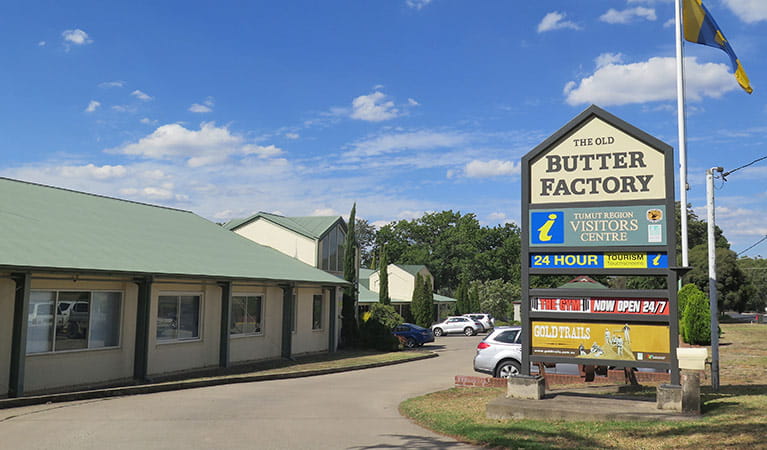
If you need some inspiration, stop by the Tumut Visitor Centre, for tips on top experiences, where to stay, and spot a corroboree frog in the display. Learn more about Kosciuszko National Park’s plants, animals and landscapes on an Aboriginal ranger-led tour (contact the visitor centre). Boat ramps on Blowering Reservoir, Talbingo Dam wall, and at O’Hares campground provide easy access for boating and paddling. There are also plenty of scenic drives, walking tracks and bike trails to tempt you away from the water. If you’re well-prepared, explore the remote Goobarragandra Wilderness or hike part of the 425km Hume and Hovell walking track.
- Black Perry lookout Black Perry lookout, near Talbingo Mountain in Kosciuszko National Park, offers scenic views over the Snowy Mountains region, and is close to Tumut and Yarrangobilly Caves.
- Tumut Visitor Centre Tumut Visitor Centre, on Snowy Mountains Highway, is the ideal starting point for a visit to northern Kosciuszko National Park, offering information, booking services, and souvenirs.
World-class wilderness
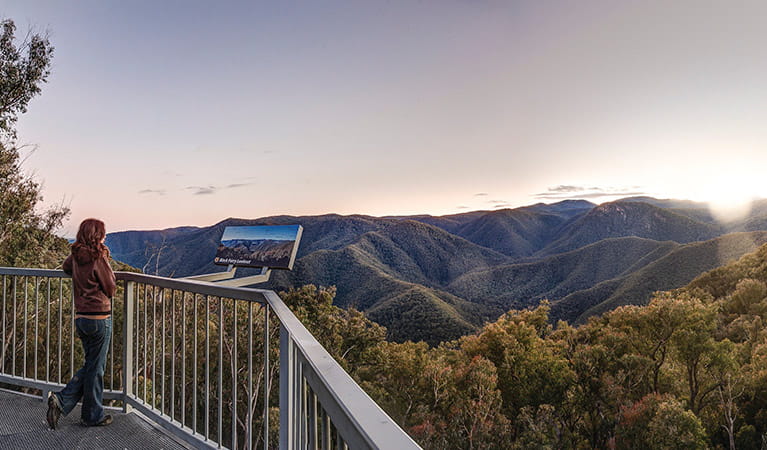
In recognition of Kosciuszko's unique value as a conservation area, it’s been named a UNESCO Biosphere Reserve. More than half of the park, over 350,000ha, has been declared wilderness, including the Bogong Peaks and Goobarragandra wilderness areas. Black Perry lookout is an excellent place to get a sense of the expansive wilderness areas in Kosciuszko's north.
Snowy Mountains history
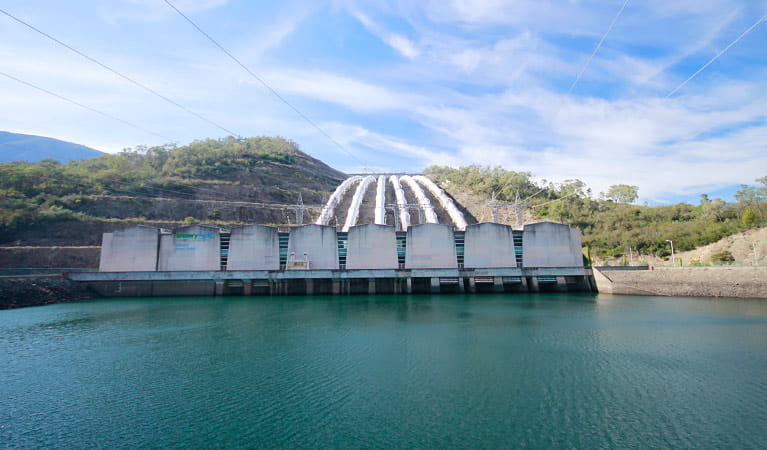
Tumut area’s more recent history can be seen at Blowering Reservoir, and just outside the park at Talbingo. The Snowy Hydro Scheme is recognised as one of the civil engineering wonders of the modern world. Its vast network of dams and power stations includes Blowering, Jounama and Talbingo reservoirs, and Tumut 3 Power Station, at Talbingo.
Unique landscapes
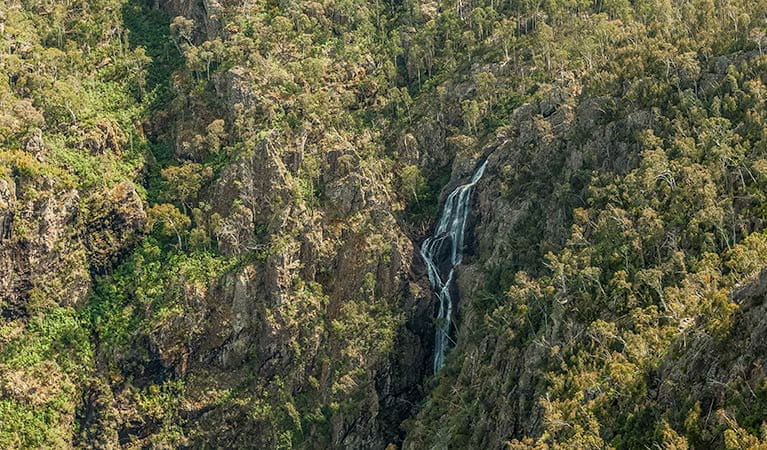
The change in scenery is noticeable as you drive along Snowy Mountains Highway. The road climbs over 1000m from the Tumut River Valley, through woodland of mountain gum and narrow-leaf peppermint, to the treeless plains surrounding Kiandra.
- Black Perry lookout Black Perry lookout, near Talbingo Mountain in Kosciuszko National Park, offers scenic views over the Snowy Mountains region, and is close to Tumut and Yarrangobilly Caves.
- Landers Falls lookout walk Landers Falls lookout walk, tucked into the forest between Tumut and Kiandra, wows you with dramatic views of Landers Creek waterfall plunging into the rocky gorge above Talbingo Reservoir.
Plants and animals protected in this park
Animals
-

Swamp wallaby (Wallabia bicolor)
The swamp wallaby, also known as the black wallaby or black pademelon, lives in the dense understorey of rainforests, woodlands and dry sclerophyll forest along eastern Australia. This unique Australian macropod has a dark black-grey coat with a distinctive light-coloured cheek stripe.
-
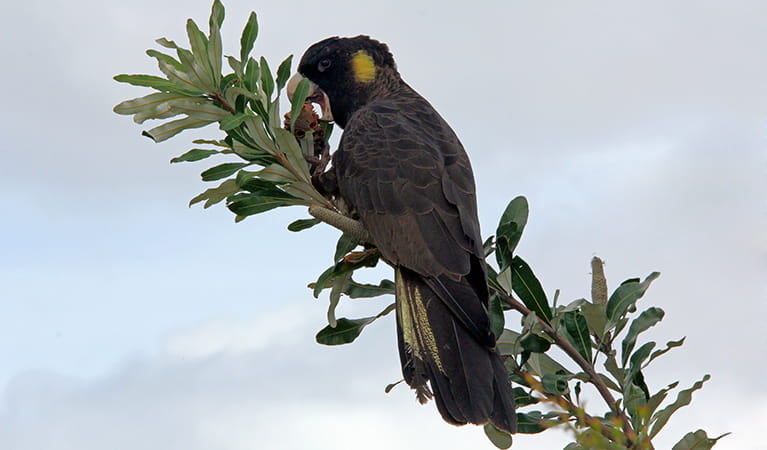
Yellow-tailed black cockatoo (Calyptorhynchus funereus)
The yellow-tailed black cockatoo is one of the largest species of parrot. With dusty-black plumage, they have a yellow tail and cheek patch. They’re easily spotted while bird watching, as they feed on seeds in native forests and pine plantations.
-
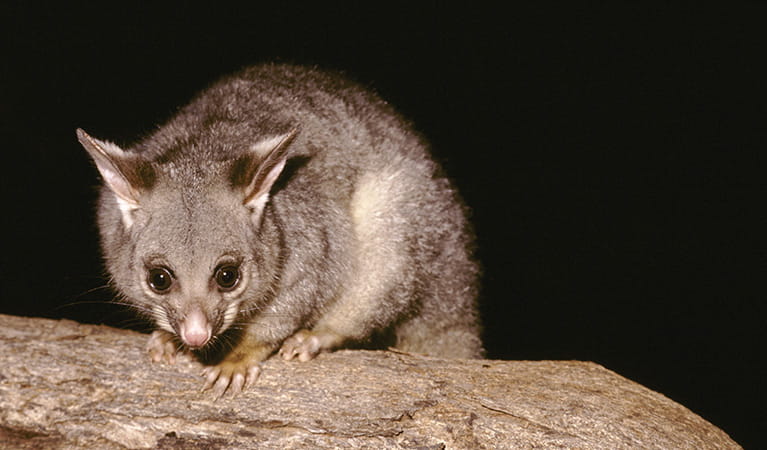
Common brushtail possum (Trichosurus vulpecula)
One of the most widespread of Australian tree-dwelling marsupials, the common brushtail possum is found across most of NSW in woodlands, rainforests and urban areas. With strong claws, a prehensile tail and opposable digits, these native Australian animals are well-adapted for life amongst the trees.
-

Common ringtail possum (Pseudocheirus peregrinus)
Commonly found in forests, woodlands and leafy gardens across eastern NSW, the Australian ringtail possum is a tree-dwelling marsupial. With a powerful tail perfectly adapted to grasp objects, it forages in trees for eucalypt leaves, flowers and fruit.
-

Bare-nosed wombat (Vombatus ursinus)
A large, squat marsupial, the Australian bare-nosed wombat is a burrowing mammal found in coastal forests and mountain ranges across NSW and Victoria. The only other remaining species of wombat in NSW, the endangered southern hairy-nosed wombat, was considered extinct until relatively recently.
-
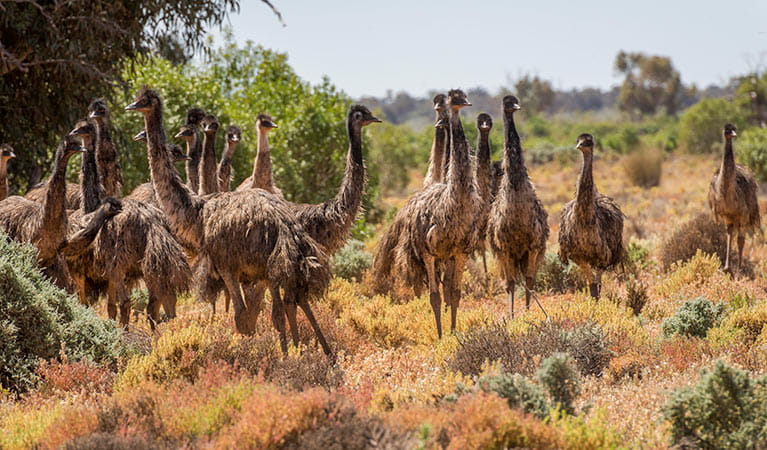
Emu (Dromaius novaehollandiae)
The largest of Australian birds, the emu stands up to 2m high and is the second largest bird in the world, after the ostrich. Emus live in pairs or family groups. The male emu incubates and rears the young, which will stay with the adult emus for up to 2 years.
-
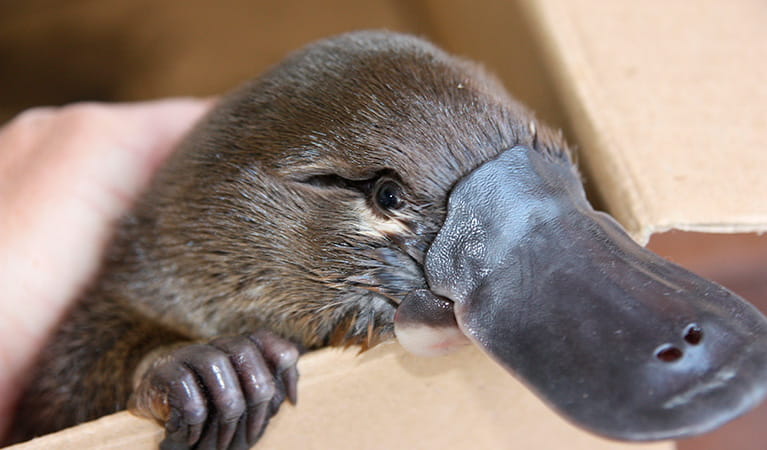
Platypus (Ornithorhynchus anatinus)
One of the most fascinating and unusual Australian animals, the duck-billed platypus, along with the echidna, are the only known monotremes, or egg-laying mammals, in existence. The platypus is generally found in permanent river systems and lakes in southern and eastern NSW and east and west of the Great Dividing Range.
-
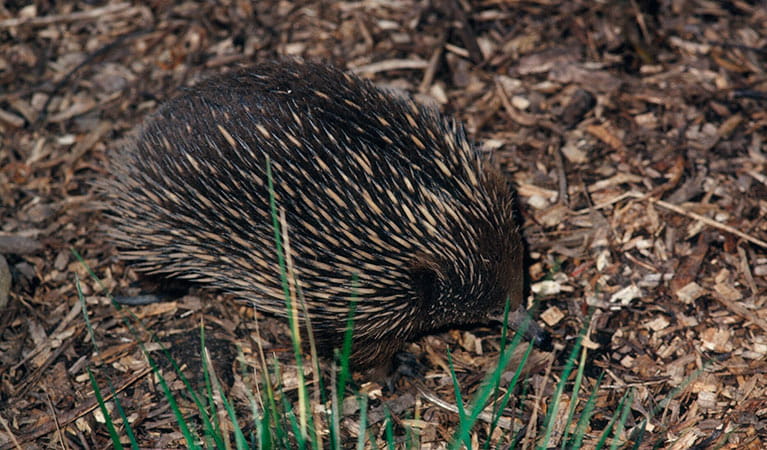
Short-beaked echidna (Tachyglossus aculeatus)
One of only 2 egg-laying mammals in the world, the short-beaked echidna is one of the most widespread of Australian native animals. Covered in spines, or quills, they’re equipped with a keen sense of smell and a tube-like snout which they use to break apart termite mounds in search of ants.
-

Superb lyrebird (Menura novaehollandiae)
With a complex mimicking call and an elaborate courtship dance to match, the superb lyrebird is one of the most spectacular Australian animals. A bird watching must-see, the superb lyrebird can be found in rainforests and wet woodlands across eastern NSW and Victoria.
-
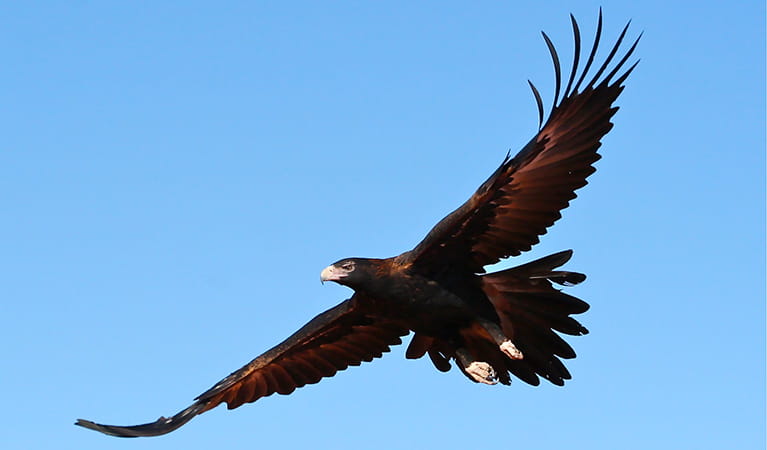
Wedge-tailed eagle (Aquila audax)
With a wingspan of up to 2.5m, the wedge-tailed eagle is Australia’s largest bird of prey. These Australian animals are found in woodlands across NSW, and have the ability to soar to heights of over 2km. If you’re bird watching, look out for the distinctive diamond-shaped tail of the eagle.

